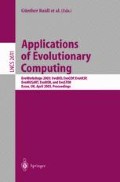Abstract
The number of local optima is an important indicator of optimization problem difficulty for local search algorithms. Here we will discuss some methods of finding the confidence intervals for this parameter in problems where the large cardinality of the search space does not allow exhaustive investigation of solutions. First results are reported that were obtained by using these methods for NK landscapes, and for the low autocorrelation binary sequence and vertex cover problems.
Access this chapter
Tax calculation will be finalised at checkout
Purchases are for personal use only
Preview
Unable to display preview. Download preview PDF.
References
Tovey, C.A.: Local Improvement on Discrete Structures. In: Aarts, E., Lenstra, J. K. (eds.): Local Search in Combinatorial Optimization. John Wiley éamp; Sons (1997) 57–90
Reeves, C.R.: The Crossover Landscape and the Hamming Landscape for Binary Search Spaces. To appear in Proc. of Foundations of Genetic Algorithms-VII. (2003)
Reeves C.R.: Fitness Landscapes and Evolutionary Algorithms. In: Fonlupt, C., Hao, J-K., Lutton, E., Ronald, E. and Schoenauer, M. (eds.): Artificial Evolution: 4th European Conference. Lecture Notes in Computer Science, Vol. 1829. Springer-Verlag, Berlin (2000) 3–20
Stadler, P.F.: Towards a Theory of Landscapes. In: Lopéz-Peña, R., Capovilla, R., García-Pelayo, R., Waelbroeck, H. and Zertuche, F. (eds.): Complex Systems and Binary Networks. Springer-Verlag, Berlin (1995) 77–163
Reeves, C.R.: Landscapes, Operators and Heuristic Search. Annals of Operations Research. 86 (1999) 473–490
Boese, K.D., Kahng, A.B., Muddu S.: A New Adaptive Multi-Start Technique for Combinatorial Global Optimizations. Operations Research Letters. 16 (1994) 101–113
Reeves, C.R.: Estimating the Number of Optima in a Landscape, Part I: Statistical Principles. Coventry University Technical Report SOR#01-03 (2001)
Garnier, J., Kallel, L.: How to Detect All Maxima of a Function? In: Proceedings of the Second EVONET Summer School on Theoretical Aspects of Evolutionary Computing (Anvers, 1999). Springer, Berlin (2001) 343–370
Reeves, C.R.: Estimating the Number of Optima in a Landscape, Part II: Experimental Investigations. Coventry University Technical Report SOR#01-04 (2001)
Eremeev, A.V., Reeves C.R.: Non-Parametric Estimation of Properties of Combinatorial Landscapes. In: Cagnoni, S., Gottlieb, J., Hart, E., Middendorf, M. and Raidl, G. (eds.): Applications of Evolutionary Computing: Proceedings of EvoWorkshops 2002. Lecture Notes in Computer Science, Vol. 2279. Springer-Verlag, Berlin Heidelberg (2002) 31–40
Seber G.A.F.: The Estimation of Animal Abundance. Charles Griffin, London (1982)
Mood, A. M., Graybill, F.A., Boes, D.C.: Introduction to the Theory of Statistics. 3rd edn. McGraw-Hill, New York (1973)
Johnson, N.L., Kotz, S.: Discrete Distributions. Wiley, New York (1969)
Liu, C.L.: Introduction to Combinatorial Mathematics. McGraw-Hill, New York (1968)
Kauffman, S.A.: Adaptation on Rugged Fitness Landscapes. In: Lectures in the Sciences of Complexity, Vol. I of SFI studies, Addison-Wesley (1989) 619–712
Golay, M.J. E.: Series for Low-Autocorrelation Binary Sequences. IEEE Trans. Inform. Theory. 23 (1977) 43–51
Johnson, D.S., Trick, M.A.: Introduction to the Second DIMACS Challenge: Cliques, Coloring, and Satisfiability. In: Johnson, D.S., Trick, M.A. (eds.): Cliques, Coloring, and Satisfiability. DIMACS Series in Discrete Mathematics and Theoretical Computer Science, Vol. 26. AMS (1996) 1–10
Garey, M.R., Johnson, D.S.: Computers and Intractability. A Guide to the Theory of N P-Completeness. W.H. Freeman and Company, San Francisco (1979)
Author information
Authors and Affiliations
Editor information
Editors and Affiliations
Rights and permissions
Copyright information
© 2003 Springer-Verlag Berlin Heidelberg
About this paper
Cite this paper
Eremeev, A.V., Reeves, C.R. (2003). On Confidence Intervals for the Number of Local Optima. In: Cagnoni, S., et al. Applications of Evolutionary Computing. EvoWorkshops 2003. Lecture Notes in Computer Science, vol 2611. Springer, Berlin, Heidelberg. https://doi.org/10.1007/3-540-36605-9_21
Download citation
DOI: https://doi.org/10.1007/3-540-36605-9_21
Published:
Publisher Name: Springer, Berlin, Heidelberg
Print ISBN: 978-3-540-00976-4
Online ISBN: 978-3-540-36605-8
eBook Packages: Springer Book Archive

